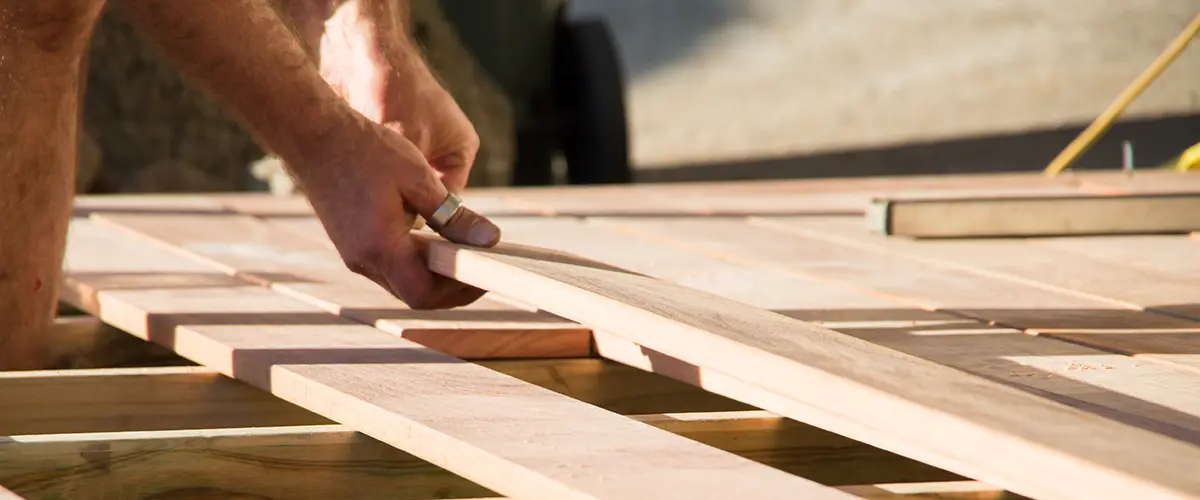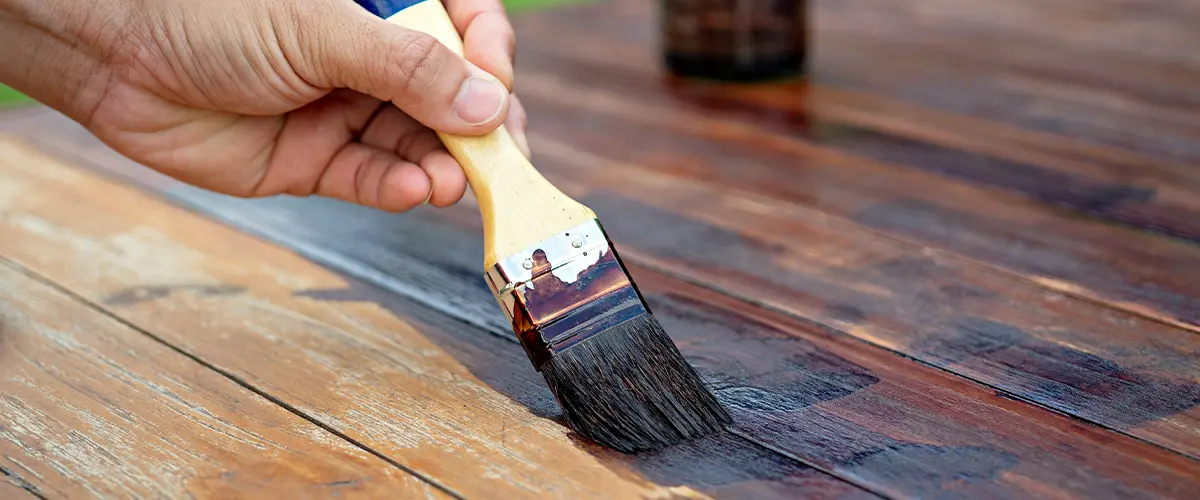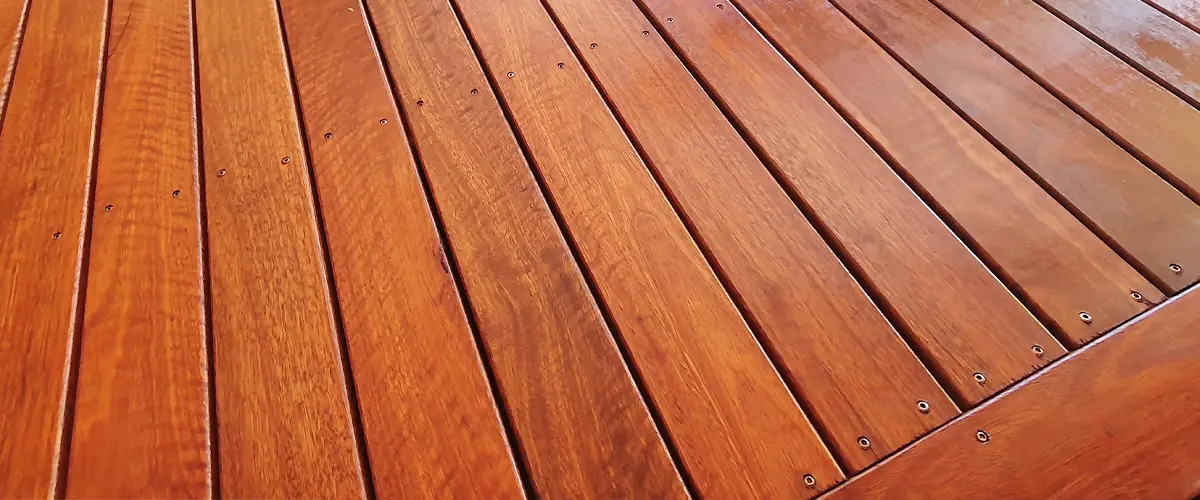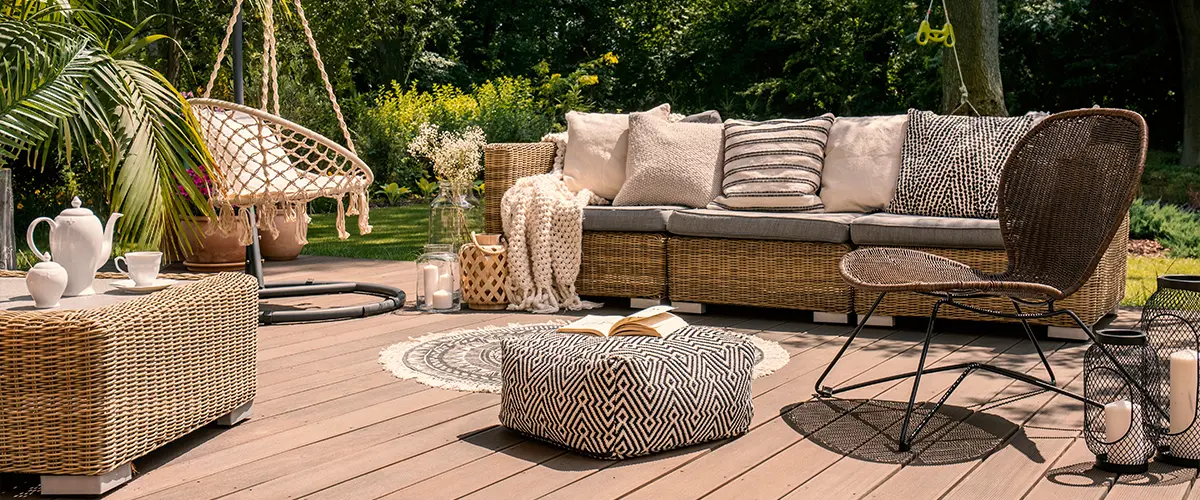Pressure Treated Vs Sealed Deck Boards In Knoxville
Choosing the right decking material can be a tough decision for homeowners. One critical choice is between pressure treated wood and sealed deck boards.
This article will guide you through understanding both options, their maintenance requirements, and how they stand up to Knoxville’s weather conditions.
Get ready to make an informed decision for your outdoor space!

Key Takeaways
- Pressure treated wood gets special chemicals under high pressure to fight off bugs, rot, and bad weather. It's strong for outside jobs like decks but needs sealing against water damage.
- Composite decking is an option too. It doesn't need as much care because it’s made to resist weather, rotting, and fading colors without needing paint or stain.
- When picking what’s best for your deck in Knoxville, think about how much you want to spend, how long you want it to last, and how much work you’re ready to do on it over time.
- To keep any deck looking good and safe for a long time, clean regularly with mild soap and check often for loose parts or damage. Use sealant when needed so moisture can’t get in.
Understanding Pressure Treated Wood and Why It Needs to Be Sealed
- What is pressure-treated lumber?
Pressure-treated lumber is wood that has been infused with chemical preservatives to protect it from rot, decay, and insects. These chemicals make the wood more durable for outdoor applications like decks, garden beds, and other projects exposed to the elements.
The treatment process involves placing the wood in a high-pressure tank where it absorbs the preservatives, ensuring deep penetration.
By undergoing pressure treatment, lumber gains added protection against nature’s toughest challenges.
- Why does it need to be sealed?
After learning about pressure-treated lumber, it’s crucial to understand the need for sealing. Sealing your deck boards protects them from moisture, which can lead to rot and decay over time.
Even though pressure-treated wood is designed to resist bugs and decay, water poses a serious threat. If not properly sealed, water can seep into the wood, causing it to swell and then shrink as it dries.
This constant cycle of wetting and drying will eventually wear down even the toughest materials.
A good sealant acts as a barrier between wood and moisture. It helps in maintaining the strength and appearance of your deck for years. Sealing also prevents mold growth that thrives in damp conditions on untreated surfaces.
By sealing your pressure-treated decks regularly, you protect your investment from weather damage, including rain exposure and ground contact moisture risks. This care extends its life span significantly while keeping maintenance costs low in the long run.
- The pressure-treating process
To ensure your pressure-treated deck boards last longer and resist decay, sealing them is essential. Now, let’s explain the pressure-treating process. This method involves infusing wood with chemical preservatives under high pressure.
These chemicals protect the wood from bugs, weather wear, and rot, making it perfect for outdoor projects like decks.
Lumber is placed in a large tank where air is vacuumed out to remove moisture from the wood pores. Then, the tank gets filled with a solution of water and chromated copper arsenate (CCA), which is forced deep into the lumber.
After this treatment, the wood becomes much more resistant to external threats and can serve as a sturdy base for many homeowners’ decks or other outdoor structures.
- Chemical preservatives used
Pressure-treated wood is infused with chemical preservatives such as copper azole, alkaline copper quaternary, or chromate copper arsenate to protect it from decay and insects.
These chemicals are forced into the wood under high pressure to ensure they penetrate deeply and provide long-lasting protection against rot and decay.
It’s crucial to understand the type of preservative used in your pressure-treated wood to make an informed decision when sealing or maintaining your deck boards.
Moving on to “How to Properly Seal Your Deck”…
How to Properly Seal Your Deck
Choosing the right sealant
When choosing the right sealant for your deck, consider factors like weather resistance, UV protection, and durability. Look for a sealant that offers water beading to protect against moisture and prevent wood damage.
Additionally, select a sealer that provides defense against harmful UV rays to maintain the natural look of your deck and prevent color fading over time.
It’s essential to choose a sealant specially designed for outdoor use, ensuring it can handle the elements and keep your deck looking great for years to come.
Selecting the appropriate sealant is crucial in maintaining the longevity of your deck. Look for sealants that offer superior protection against moisture and UV rays to keep your deck looking pristine while standing up to harsh weather conditions.
Prepping your deck
Before sealing your deck, it’s crucial to prep the surface properly. Start by cleaning the deck thoroughly using a suitable cleaner to remove any dirt, debris, or old sealant. Ensure that the wood is completely dry before applying the new sealant.
Sanding any rough spots and repairing any damaged areas will help in achieving a smooth and even finish. Additionally, make sure to cover nearby plants and delicate surfaces with plastic sheeting to protect them from any potential damage during the sealing process.
Once you’ve completed these steps, your deck will be ready for a fresh coat of sealant to protect it from weather elements and ensure its longevity.
Remember that proper preparation is key for a successful sealing job that will keep your deck looking great for years to come.

Applying the seal
To seal your deck, start by choosing the right sealant for your pressure treated wood. Prep the deck by cleaning it thoroughly and ensuring it is completely dry before applying the seal.
When ready, use a brush or roller to apply an even coat of sealant, following the wood’s natural grain. Allow sufficient drying time as per the manufacturer’s instructions before enjoying your newly sealed deck.
Regularly reapply the sealant every few years to maintain its protection against moisture and wear, ensuring long-term durability and beauty for your outdoor space.
Drying time
It’s crucial to check the product instructions for specific guidance on drying times based on humidity and temperature in Knoxville.
Ensuring adequate drying time will help protect your deck boards from moisture damage and extend their lifespan, keeping them well-maintained for long-term use.
Following these guidelines will aid you in choosing between pressure-treated wood and sealed deck boards while enhancing your outdoor living space with a new deck or maintaining an existing one.
Comparing Pressure Treated Wood and Composite Decking
Features of pressure-treated wood
Pressure-treated wood is infused with chemical preservatives to resist rot, decay, and insect damage. This makes it highly durable for outdoor applications, particularly in decks and fencing.
It can withstand weather elements like a champ and is more cost effective than composite decking. Pressure-treated wood also offers versatility as it can be stained or painted to achieve the desired look for your specific project.
Furthermore, it’s an excellent choice if you’re seeking a more natural appearance that blends seamlessly with your outdoor living space.
The water beads on the surface of pressure-treated wood indicate that it’s ready for staining. This saves time and money while providing long-term benefits for your deck or other outdoor projects.
Additionally, pressure-treated wood comes in various types catering to different specific projects and budgets making it a versatile option for homeowners seeking to enhance their outdoor living spaces without breaking the bank.
Features of composite decking
Composite decking offers durability, low maintenance, and a range of color options. It is resistant to rotting, warping, and insect damage. Additionally, it provides homeowners with a long-lasting solution to their outdoor living space needs.
Composite decking also boasts eco-friendly benefits as it is typically made from recycled materials and doesn’t require chemical treatments for preservation.
Another key feature of composite decking is its resistance to fading. This means that the vibrant color you choose will remain vibrant without the need for staining or painting over time.
Furthermore, composite decking often comes with extended warranties due to its durable nature, offering peace of mind for homeowners investing in their outdoor spaces.
Which is best for your specific project?
Choosing the right wood for your deck is crucial. Pressure-treated wood is great for durability and cost-effectiveness, making it ideal for outdoor projects in Knoxville.
On the other hand, sealed deck boards offer a more natural look and are low-maintenance, perfect for homeowners seeking a long-term solution with less upkeep.
Consider your specific needs and maintenance preferences when deciding between pressure-treated and sealed deck boards to ensure your project’s success.
When selecting the materials for your outdoor project, consider factors such as climate, budget, desired appearance, and required maintenance. For example:
- If you want a durable material that requires minimal maintenance but has a chemical preservative element incorporated into it - pressure treated lumber could be an excellent fit.
- If you're looking for a low-maintenance solution with a more natural appearance - sealed deck boards might better suit your specific project requirements.
Top Manufacturers of Decking Materials
- Trex: Known for high-quality composite decking with excellent durability and a variety of color options.
- TimberTech: Offers composite decking renowned for its realistic wood appearance and low-maintenance features.
- Fiberon: Specializes in eco-friendly composite decking made from recycled materials, providing longevity and sustainability.
- YellaWood: Offers premium pressure-treated wood that is durable and resistant to rot and insect damage.
- Deckorators: Provides versatile decking materials with innovative designs and a range of style choices for outdoor spaces.

Enhancing Your Outdoor Living Space with a New Deck
Benefits of a well-maintained deck
A well-maintained deck not only enhances your outdoor living space but also adds value to your home. It provides a beautiful and functional area for relaxing, entertaining, and enjoying the outdoors with family and friends.
Additionally, regular maintenance helps protect your investment by extending the life of your deck, preventing costly repairs, and ensuring a safe environment for everyone to enjoy.
Proper care of your deck includes regular cleaning, sealing or staining as needed, and inspecting for any signs of wear or damage.
By choosing the right materials initially and maintaining them properly over time, you can ensure that your deck remains a stylish and durable outdoor retreat for years to come.
Next: Choosing the right wood for your deck
Choosing the right wood for your deck
When choosing the right wood for your deck, consider pressure-treated lumber due to its durability and resistance to decay. Opt for cedar or redwood if you prefer natural beauty with added insect resistance.
Ensure your selected wood is suitable for outdoor use to withstand varying weather conditions.
Selecting the appropriate wood for your deck is crucial in ensuring longevity and minimal maintenance. Pressure-treated lumber, cedar, and redwood are top choices known for their durability and insect resistance, making them ideal for outdoor decking projects.
Be sure to assess each option’s suitability based on your specific project needs while considering factors such as cost and aesthetic preferences.
Other factors to consider
When considering other factors for your deck, think about the climate in Knoxville. The weather can affect the longevity of your deck, so choose a wood that can withstand the local conditions.
Additionally, consider the maintenance requirements of different wood types to ensure you select one that fits your lifestyle and schedule. Finally, factor in the cost of materials and ongoing maintenance to make an informed decision for your new deck project.
Consider untreated lumber if you prefer a natural look and are willing to put in extra effort for maintenance. On the other hand, pressure-treated wood is more durable but may require sealing every few years.
Consider these factors carefully before making a decision on the best wood for your new deck.
Maintaining your deck for long-term use
- Regular Cleaning: Keep your deck clean by sweeping off debris and dirt regularly. Use a mild detergent and water to scrub the surface and prevent the accumulation of mold and mildew.
- Inspect for Damage: Periodically inspect the deck for any signs of damage such as rotting or splintering boards, loose fasteners, or protruding nails. Address any issues promptly to avoid further deterioration.
- Apply Sealant: Reapply a high-quality sealant every 1-3 years, depending on foot traffic and weather conditions. This will protect the wood from moisture, UV rays, and other elements that can cause deterioration.
- Repaint or Stain: If you have a painted or stained deck, periodically repaint or restain it to maintain its aesthetic appeal and provide an additional layer of protection against the elements.
- Check Structural Integrity: Ensure that the structural components of the deck, such as posts, beams, and joists, are stable and not showing signs of rot or insect damage.
- Trim Vegetation: Keep nearby vegetation trimmed to prevent overhanging branches from damaging the deck surface while also allowing air circulation to minimize moisture retention.
- Professional Inspection: Consider hiring a professional inspector to assess your deck's condition periodically for any hidden issues that may require attention.

Pressure Treated vs Sealed Deck Boards - FAQs
Why Choose Our Professional Team
Our team has been providing this service for years, and they are true professionals. As with anything in life, working with the best ensures superior results, ultimately saving you money in the long run.

